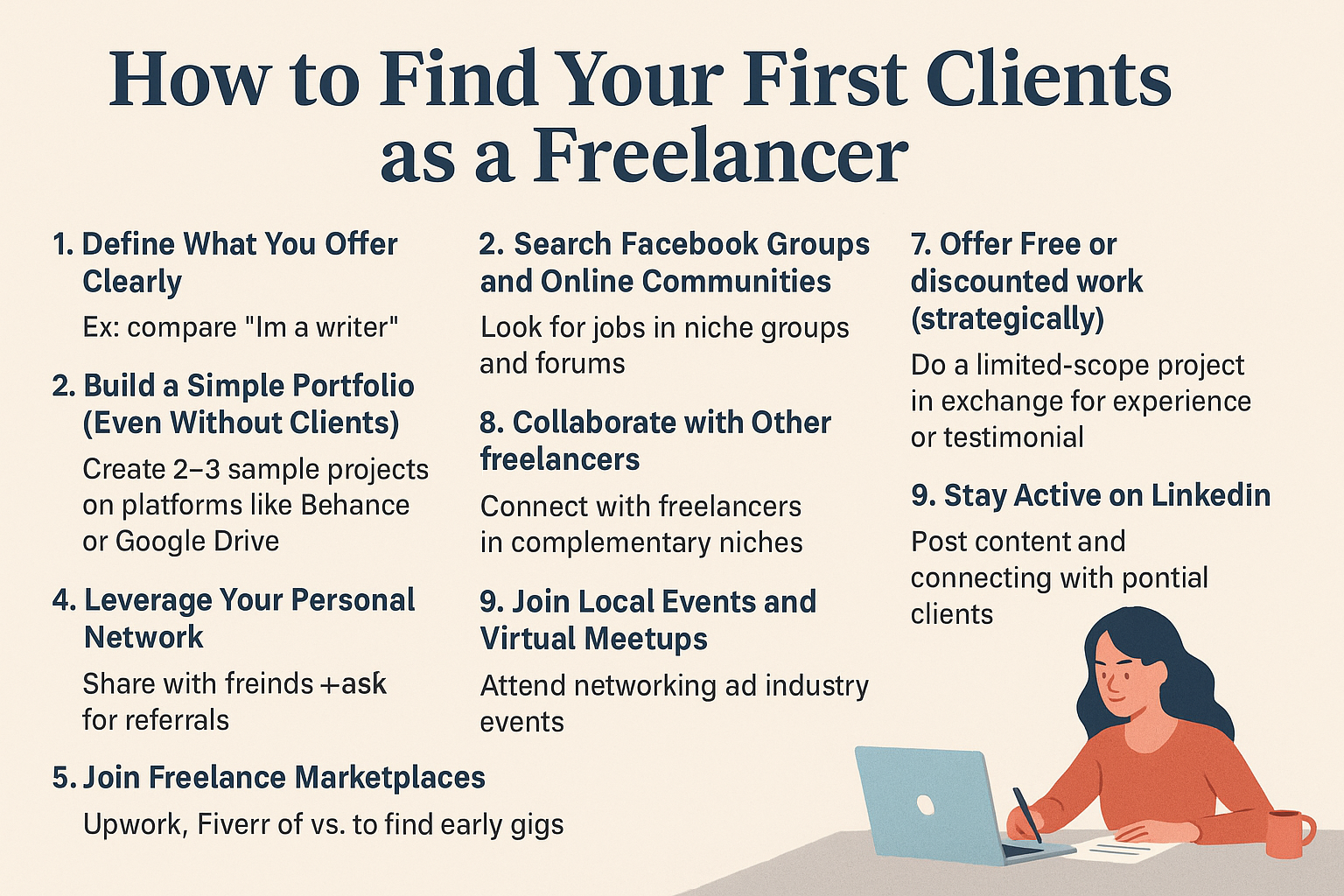Starting a freelance career is exciting—but one of the first and biggest hurdles is landing your first paying clients. Without a track record or client testimonials, it can feel like a catch-22: you need experience to get work, but you need work to get experience. The good news is that many successful freelancers have faced and overcome this same challenge. In this article, we’ll show you step-by-step how to find your first freelance clients—even if you’re starting from scratch.
1. Define What You Offer Clearly
Before searching for clients, you must know what you’re offering. A confused freelancer rarely gets hired.
Be specific:
- Instead of “I do design,” say “I create modern logos for small businesses.”
- Instead of “I’m a writer,” say “I write SEO blog posts for tech startups.”
The clearer your niche and value proposition, the easier it is to attract the right clients.
2. Build a Simple Portfolio (Even Without Clients)
You don’t need a fancy website to start, but you do need to showcase your skills. Create 2–3 sample projects tailored to your ideal client.
Options:
- Design mock logos or landing pages for fictional businesses
- Write blog posts or emails for imaginary companies
- Record sample videos or edit footage from public domains
Host your work on free platforms like Behance, Clippings.me, Google Drive, or Notion.
3. Leverage Your Personal Network
Your first clients often come from people you already know: friends, family, former colleagues, or classmates.
How to approach:
- Send personalized messages sharing what you’re doing
- Ask if they know someone who might need your services
- Offer a discount in exchange for a testimonial
Don’t underestimate your existing connections—they may lead to your first opportunities.
4. Join Freelance Marketplaces
Freelancing platforms are great places to find early clients. These include:
- Upwork
- Fiverr
- Freelancer.com
- Workana
- PeoplePerHour
Tips to stand out:
- Create a strong profile with samples and keywords
- Apply to projects quickly and write personalized proposals
- Start with lower rates (temporarily) to get initial reviews
- Always deliver excellent work, even for small jobs
5. Search Facebook Groups and Online Communities
There are thousands of niche communities where people post freelance gigs and ask for recommendations.
Try:
- Facebook groups like “Freelance Writers Hub” or “Remote Jobs for Creatives”
- Subreddits like r/freelance or r/forhire
- Slack groups for your industry
- Discord servers for entrepreneurs or startups
Be helpful, participate in discussions, and look out for job posts.
6. Cold Email Potential Clients
Cold emailing still works—especially if you target the right people with the right message.
Steps:
- Identify businesses or individuals who might need your service
- Find their email on their website or LinkedIn
- Send a short, personalized pitch explaining:
- Who you are
- How you can help
- A link to your portfolio
- A clear call to action
Example:
“Hi Sarah, I saw your beautiful handmade jewelry site and noticed your product descriptions could benefit from SEO optimization. I’m a freelance writer specializing in e-commerce. I’d love to offer a free review or rewrite one listing to show how I can help. Here’s my portfolio: [link]”
7. Offer Free or Discounted Work (Strategically)
This doesn’t mean working for free forever. But offering a trial project or limited discount can help you gain experience, testimonials, and confidence.
Best practices:
- Clearly limit the scope (e.g., “1 logo for $50” or “1,000-word article”)
- Always ask for permission to display the project in your portfolio
- Focus on clients who could refer you to others or give public testimonials
8. Collaborate with Other Freelancers
Connect with freelancers in complementary niches—they often have overflow work or need someone to help finish a project.
Examples:
- A web developer might refer you as a designer
- A content writer might recommend an SEO specialist
- A VA might need help with blog formatting or visuals
Be generous, collaborative, and open to partnership opportunities.
9. Join Local Events and Virtual Meetups
Even in a digital world, personal connections can lead to work. Look for:
- Local networking events
- Industry webinars or Zoom workshops
- Co-working spaces or creative hubs
- Online conferences with chat rooms
Practice a short “elevator pitch” and bring business cards or portfolio links.
10. Stay Active on LinkedIn
LinkedIn is a powerful tool for building a professional brand and attracting clients.
Quick wins:
- Optimize your headline (“I help coaches grow with SEO content”)
- Post content regularly (tips, client stories, behind-the-scenes)
- Connect with people in your industry
- Engage on posts from potential clients
You don’t need thousands of followers—just the right ones.
Final Thoughts: Be Patient and Consistent
Finding your first freelance clients can take days—or weeks. It’s normal to face rejection or silence at the beginning. What matters is staying consistent, improving your pitch, and learning from each experience.
Your freelance business will grow with every:
- Email you send
- Proposal you write
- Sample you create
- Connection you build
The first client is the hardest—but once you land them, more opportunities start rolling in. Keep going. You’ve got this.

